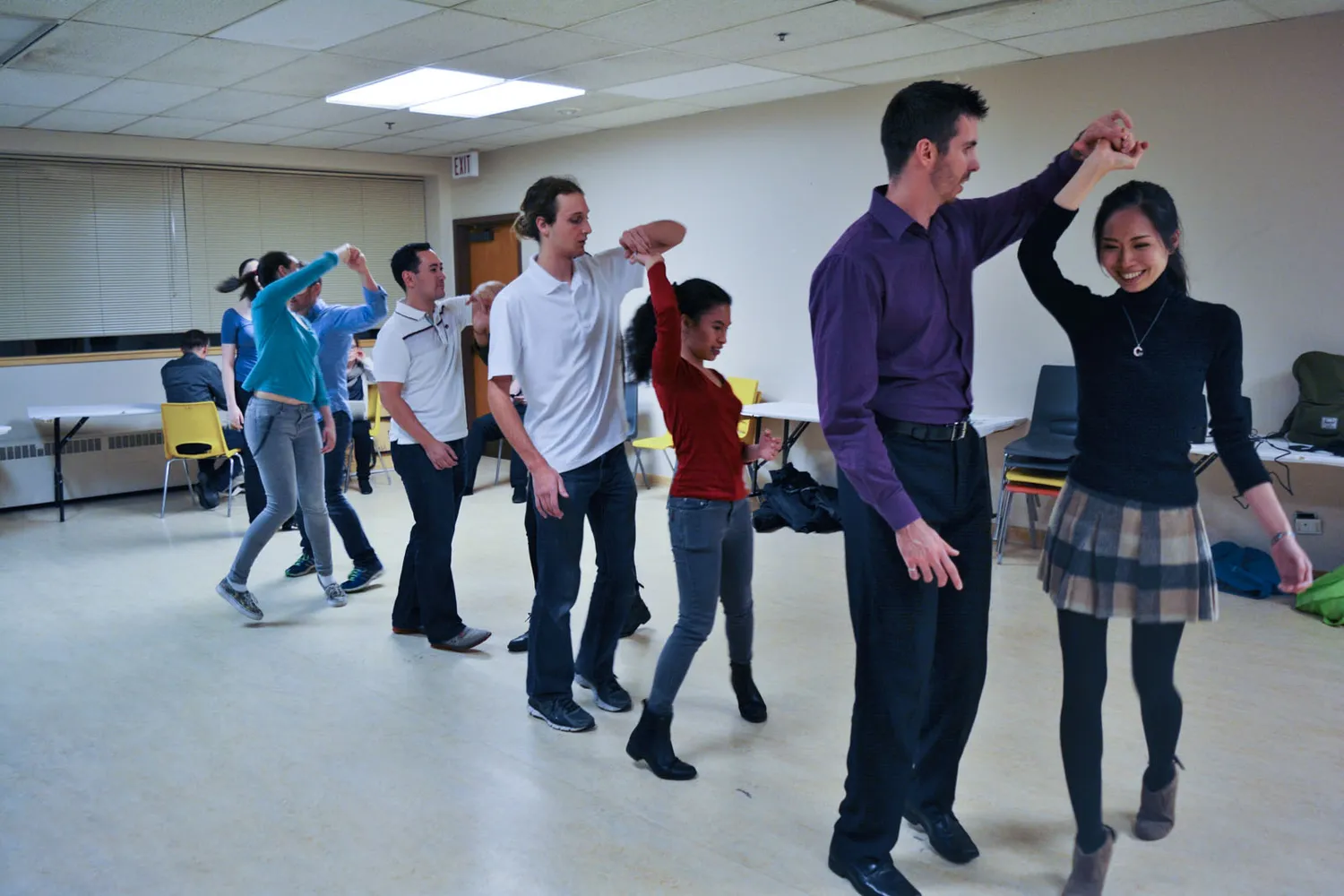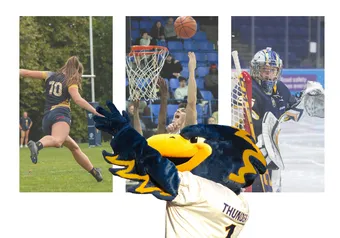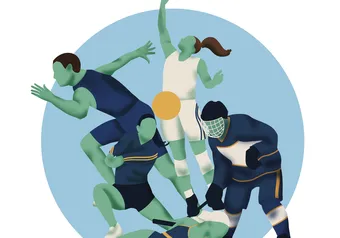Have you ever wondered what kind of dance styles are active on campus? Here are the different styles each dance clubs offers at UBC!
UBC Dance Club
The UBC Dance Club is possibly one of the oldest clubs on campus. The club was originally part of the UBC Music Society back in 1919 until it branched out to be its own club in 1949.
Their primary focus is Latin and standard international ballroom dancing.
The club has boasted around 200 to 300 dancers each year for the past five years, but its heyday was back in the 80s. Back then, its membership skyrocketed to 1,600.
According to club president Theresa Bonardchuck, that period was the club at its peak. However, due to the amount of clubs that have sprouted up since then, its popularity has waned.
The dynamic of the club has also varied throughout the years. In some years, the club was more competition-focused while in other years, it became more focused on the social side of things.
“This year we took the social approach,” said Bonardchuck. “We really focused on making sure there were enough social dances that people can come out to.”
Two of the largest events that the club hosts are the team match and the holiday ball. “Team match is held sometime in October [or] early November, and has several different teams who come together to build a silly dancing skit,” said club social coordinator Ezra Parker.
“Usually there’s a certain theme to team match — we usually have the teacher come to judge and it’s lots of fun,” said Parker .
“You have people doing absolutely ridiculous things. We had some dancing zombies last year and this year, we had people dancing with horses.”
According to Parker, the holiday ball acts as “really big wrap-up event of the year.” The event takes place in November or December.
“There’s dinner, there's dancing, usually there’s some silly performances or different kinds,” said Parker . “It’s a great way to get together, semi formal event in the evening.”
Dance Club will be hosting Dance Conventions, an event where members get to learn new styles of dance such as Paso Doble and Viennese Waltz. They will also organize the gala ball. This is their annual dance competition that has been running since 1962.
Dance Horizons
Dance Horizons was founded as Danceworks UBC in 1983, a theatre project from Ballet UBC jazz club. The club’s name was re-branded to Dance Horizons in 1984. They currently have around 140 dancers.
Dance Horizons prides itself on offering a large number of dance styles and different levels of dance classes. They are especially open to beginners, and also welcome dancers who have more experience.
“We’re always open to new ideas and we’ve been opening up to new styles rather than just ballet and hip hop,” said club president Caitlin Lee.
“Voguing was something we introduced this year. We’ve never had that before.”
If you’re looking for something more challenging, Dance Horizons offers three dance teams that vary in style and difficulty — DHCo, DHC and DHX.
“DHCo is our contemporary team, catered more towards beginner dancers,” said Lee. “DHC is the hip hop team. Some of the more experienced dancers are in there and they help out the beginners.
“DHX is the performance team. It combines contemporary, jazz and hip hop. Some of the dancers are stronger in one of the styles more than the other, but they are willing to take on the challenge of another style.”
According to Lee, the club organizes gatherings like flash mobs to promote arts and culture on campus throughout the year. In addition, they team up with other groups on campus to put together dance week in February. During that week, each dance club hosts a class of their own.
The club's mid-year and year-end shows are also a big deal. A part of the ticket sales are usually given to charitable clubs on campus like the Dollar Project and the Heart & Stroke Foundation.
However, the club has had to deal with unforeseen costs this year. This was because the Norm Theatre, a theatre they normally used for their shows and which was free to rent, was being renovated. They thus had to rent the Frederic Wood Theatre.
“It was an expense that we weren’t expecting,” said Lee.
Unlimited Dance Club
In 2009, a group of Korean breakdancers — also known as Bboys — searched for a club at UBC that would reflect their dance style. They came away empty-handed.
In their disappointment came the inspiration to start a movement at UBC that is still growing till today. The Unlimited Dance Club (UDC) was born.
“When we first started, we had too many classes. They weren’t really popular enough and people didn’t come out that much, which was financially hard for us,” club president Carson Shi said.
“There were like 20 people when I joined and [our] competitive choreography team had like 10 to 15 people.”
Through hard work and plenty of promotion, UDC now has about 150 dancers. “Dance classes are doing so much better and they are finally breaking even financially,” said Shi .
“We sold a lot of our class packages. We are able to pay off the teachers and average class size went from four to five in previous years, to 15 to 20, which is a big improvement.”
UDC’s competitive choreography team was first named NUera. But after finding out about a dance crew in the US that was named similarly, the team was re-branded to Project U&G.
“They won CVC Super Skillz last year, and also last year they did World of Dance, [which] was all the way in Edmonton,” said Shi .
“It was the first time that they ever performed at something so big and in the future, they wish they can get to the point where they get to go to larger scale competition like HHI (Hip Hop Internationals).”
The biggest event of the year for UDC is the Unlimited Styles competition, their year-end dance battle. It usually takes place at the end of second term.
“We’ve hosted it about three times now,” said Shi. “The first time we hosted it was about six years back. It was really, really good.”
According to Shi, the clubs falling popularity two years ago meant that the event's reception was not as good. But it has gotten better.
“Last year, when we hosted it, it was when our club had actually gotten really big and that's when it really stood out.”
UBC Ballet Club
The UBC Ballet Club is the latest addition to the UBC dance community. Founded three years ago, the club now boasts about 30 members — many of which are new to the club.
“Last year was the year that the club started to get big because the execs really put in effort to promote the club and make events,” said club president Shirlei Ishizaki.
“That was the time when we had the greatest amount of members. That's also when we started the recreation team,” said Ishizaki. “This year we’re having a hard time getting members, especially for the recreation team.”
The club is run entirely by students. There are no outside teachers, and members help teach and choreograph routines for competition and performances. In addition, it has classes for both beginners and dancers with more experience. They also have a competition team for dancers looking for something more challenging.
“Last year, we went to Vancity Project and we also went to the Surrey Dance Festival, where we danced in the adult division and placed first,” said Ishizaki. “This year, we’re going to Surrey Dance Festival again and another competition in late January.”
One of the events that Ballet club hosts is the annual calendar photo shoot. Anyone is welcome to attend and it is a chance for dancers to have fun. They also have a year-end show in March.
“Ballet is the base of every dance style. It’s the technique part of the dance,” said Ishizaki. “I encourage people to do ballet even if they do hip hop, or contemporary, or even figure skating.”
UBC Dance Team
Founded in 2009, the UBC Dance Team focuses on styles such as contemporary, jazz, ballet and tap.
They are a performance-based team and you can catch them at a number of events. Past events include UBC Recreation's Lace Up For Kids and the Wesbrook Village Festival.
One of the highlights of their year is the year-end show.
“Having a recital at the end of the year to showcase all the different routines that we’ve been working on is definitely really fun,” said club president Allie Stephen. “We also partner with World Vision for our year-end show and the proceeds of the ticket sales go to them.”
According to Stephen, the team is comprised of former competitive dancers. “It came out as a club because dancers wanted to continue [dancing] in their academic studies,” said Stephen.
“Not necessarily at the same level, but in some capacity because it's hard to let go of once you’ve gone through that intensity for however long in your life.”
The team has grown in size. When it started in 2009, there were about eight members. Now the team boasts approximately 16 members and has been that size for about five years.
“Having a larger team, we’re able to have that dynamic and there are more types of dances that we can do,” said Stephen. “We can do a large group, or we can split into a couple different groups and have different styles in each group.
“We’re able to do more in that sense”
Thunderbird Dance Team
The Thunderbird Dance Team (TDT) was originally founded as a part of varsity athletics. Since then, it has transformed into a performance-based dance group. The team performs at different venues on UBC’s campus as well as off-campus.
Its members celebrate their love of dance and express it through hip hop and jazz.
The TDT consists of approximately 15 members each year. Interestingly, the group rarely brings in guest choreographers to help out.
“I’ve done a number on my own. Martina’s contributed a lot as well, but we leave it open to all members. If someone has an idea, then we’re totally open to letting it happen,” said the team's vice president external Rebecca Moug. “It’s a good way to encourage each other creatively.”
“We’re not a competition-based team, so a lot of the performances that we do are mainly showcases, not actual competitions,” said Martina Knappett, the vice president internal.
According to TDT's club president Vanessa Bermisa, there aren’t many competitions for older aged groups. “There are so many festivals and dance conventions when you’re younger, but once you get a little bit older, it’s kind of like your options are narrowed.”
TDT's event of the year is called Get Schooled. It is an all-styles, all-level dance off. “It’s just held in the Agora, so it’s open to everyone. It’s totally free. It’s for people to come watch or even just look over the railings and hang out for a little bit,” said Bermisa.
“That's like our main event where we try to bring the community together,” said Knappett. “It’s so much fun to see all the talent out there ... like that one guy in your computer science class — maybe he can spin on his head!”
During the event, there’s an amateur round where people in the crowd are invited to show off.
“We have people who have never danced a step in their life come up just to goof off with their friends,” said Moug.
“We make it entirely inclusive to everyone in UBC, not just the dance community, but anyone who wants to participate and have fun.”
UBC Bhangra
UBC Bhangra started in 1992. The club was created to show culture through Bhangra — a traditional dance from the Punjab region in India. It was also created as a social club where people could hang out. Currently, the club has about 60 members.
“We have three teams [which are] the co-ed Bhangra team, the ladies Bhangra team and we also have a Giddha team which is just girls as well, but a different kind of dance — it is more like folk dance,” said co-president Anmol Toor.
“None of our teams compete right now. Back then, the girls Bhangra team won a lot of titles. They were the first girls team to win at an all-male competition, but now it’s more of a showcase of talent.”
According to Toor, the club's large events usually bring about 700 attendees. One particular event called Fusion tries to blend Indian culture — particularly Punjabi — and western culture.
“As students, we’re kind of half-and-half, so it’s nice to have an event which includes both of our cultures,” said Toor. “I feel like that attracted a lot of students.”
They also have an event in March called Formal and as the name suggests, it’s a bit more formal.
“There’s dancing and a dinner. It’s basically more large scale. We also wear Indian attire whereas to the other events, we just wear western attire,” said Toor. “It’s official name is called Nach for the cause. Nach just means dance.”
UBC Bhangra is involved in charity, so every penny earned at their events goes to a charitable foundation.
“The reason we put on these events is because we want something that students can attend at UBC, but every single dollar that we collect goes to charity,” said Toor.
“We always try to surpass our previous year’s donations,” said Avneet Athwal, the club's treasurer. Harpawantaj Toor, the club's other co-president of the club, mentions that the club donated about $30,000 from its collected funds.
Past recipients of donations have been the BC children's hospital and Make-A-Wish foundation.
“Every year we choose a new charity. This year is Khalsa Aid and we’re also giving some funds to Kids Play, which is a local charity,” said Anmol Toor.
UBC Rueda
You almost never see UBC Rueda members promoting their club due to their large amount of members. Sometimes it’s to the extent where they can barely handle the numbers.
At one point, the club had around 1,200 active members and even now, they have 40 to 50 people show up to classes every week. It is strange that the only way people hear about it is through word of mouth from friends who went and had a great time.
“Our club started when two law students, Sam Turcott and Martin Ferreira Pinho, wanted to share their passion for dance with everyone back in 2011,” said club treasurer Adi Steif.
“The club actually split from a club called ALAS (Association of Latin American Students at UBC) because it got too big.”
Every week, UBC Rueda holds classes at the International House where advanced members teach complementary lessons. Classes consist of three circles — beginners, intermediate and advance. At the end of class, everyone gathers around in a giant circle and dances together, usually in basic steps so that the beginners can join too.
“We didn’t charge anything to the members until we became an official club of the AMS,” said Steif. “Then we charged the minimum $1 for students of UBC and $1.5 for non-UBC students.”
UBC Rueda also hosts various events throughout the year.
“Last year we fundraised $600 for Directions Youth foundation by holding dance lessons,” said club president Diana Ihnatovych.
“One of our members also participated in an art competition with the with the topic ‘heart art’ by having the Rueda club dance in the shape of an heart, which won first place!”
UBC Junoon
UBC Junoon is a Bollywood fusion team that was founded four years ago. Its focus has changed largely from the Raas Garba team that it originated from. Raas Garba is one of the dances from the state of Gujurat in India.
“Ever since then, we’ve been competing in what we like to call a ‘Bollywood circuit,’ so basically we compete against other universities teams that have both co-ed and single gender teams,” said Sarina Prasad, one of the club's co-presidents. “The goal of the competition is to take it to the Bollywood championship called Bollywood America.”
Bollywood America is the biggest competition in North America. It’s where all the best teams from the US and Canada go to compete against each other. To get there, teams have to go through smaller competitions and accumulate points by either winning or coming second or third. If a team gets enough points, they will enter Bollywood America, which usually happens around the end of March.
“That’s basically the goal of the team. Since we’re a fairly new team, we’ve never made it that far to Bollywood America. But we’ve been competing so far at this competition in Toronto called Bollywood Dance Canada,” said Prasad.
This year the team is going to a new competition in San Antonio, Texas called Sitara. "It’s the first time that the team is competing in the states. So it is a pretty big milestone for our team,” said Prasad.
A big challenge that the club has overcome is membership. When UBC Junoon first started out, the team had about 12 dancers and due to it being a large commitment, the turnout was low.
“Since then, we’ve had more and more commitment. This year, we are 25 large,” said Prasad. “That’s basically the capacity that we can reach for these competitions.”
As a Bollywood fusion team, UBC Junoon incorporates a lot of different styles into their dance. These range from Bollywood dancing, bhangra and other classical Indian dancing, to hip hop and contemporary dancing.
“Our dances tell a story. Sometimes they recreate the story of a movie that has come out or a Disney fairytale,” said Prasad. “We come up with a story and then we have an intro video to our dance, which is usually a two-minute long video where we just lay the ground out for the story.
“Then we go into our dance which tends to be an eight-minute dance.”
The club sometimes organize samosa sales around campus, either bi-weekly or once a month. They also do club fundraisers, which happen both at the pit and downtown.
A new thing that club started doing this year was a movie night where they play an Indian movie. In November, they watched a movie called Three Idiots.
“It’s a very famous movie that kind of resonates with the entire community,” said Prasad.
Apart from fundraising for their competitions, Prasad said that the club's events are a good way to show their culture.
“Even the club nights that we hold, they tend to be ones where they play Indian music or Bollywood music,” said Prasad. “So all our fundraisers are all tied to that cultural aspect.”
Share this article
First online



![['']](https://storage.googleapis.com/ubyssey/media/renditions/Shot_by-_Timothy_Tan-Edited_by-_.width-1000.format-webp.webp)
![['']](https://storage.googleapis.com/ubyssey/media/renditions/_20151020_Cherihan_Hassun.width-1000.format-webp.webp)
![['']](https://storage.googleapis.com/ubyssey/media/renditions/UnlimitedDanceClub_JoshCurran.width-1000.format-webp.webp)
![['']](https://storage.googleapis.com/ubyssey/media/renditions/Ballet_20151103_Courtesty_Justin.width-1000.format-webp.webp)


